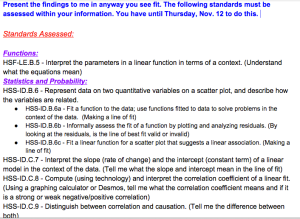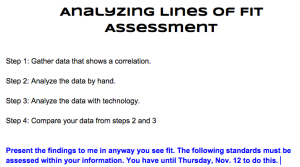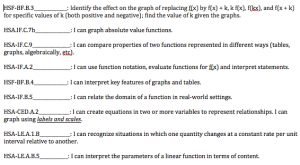Daily Archives: November 11, 2015
9 Things that Happened When I Changed the Way I Assessed Students
The methodology of testing seems to be a timeless tradition in the math classroom. Halfway through the chapter, you would give a quiz and at the end of the chapter, the students would take a test. Until recently, that’s what I did as well. During the last year, I have changed the way I assess students. While changing the way I assess, I have made some observations.
- I no longer differentiate between a test or a quiz. I simply refer to my quizzes and tests as assessments. If the purpose of a quiz or a test is to assess students over material, why do we put a different emphasis on them by calling them something different? Worse yet, I used to assign different point values or percents in the grade book for each test or quiz. By calling them assessments, it doesn’t skew the importance of what we are assessing.
- The assessments I give are now aligned to the standards. With the implementation of Standards Based Grading (SBG), I now put the standards next to each problem. While doing so, it made me take a hard look at the quality of my assessments. I also realized that there were standards that I wasn’t assessing to the extent as what I thought. I also give students the standards so they know what is expected of them. The following picture is what I put on their open-ended assessment I gave them this week:
 Students have choice in their assessment. When you think of an assessment, you often think of using paper and pencil to assess students. While I still give paper and pencil tests for some assessments, I also have been allowing students the opportunity to show their mastery of the content in the ways they choose. I have now given open-ended tests where I will say, “Prove to me you have mastered the following standards.” Students present their mastery by using whatever they see fit. Some students made presentations while other students present it on paper. In the following picture, this is all I gave them for proving 7 high school standards for analyzing lines of fit.
Students have choice in their assessment. When you think of an assessment, you often think of using paper and pencil to assess students. While I still give paper and pencil tests for some assessments, I also have been allowing students the opportunity to show their mastery of the content in the ways they choose. I have now given open-ended tests where I will say, “Prove to me you have mastered the following standards.” Students present their mastery by using whatever they see fit. Some students made presentations while other students present it on paper. In the following picture, this is all I gave them for proving 7 high school standards for analyzing lines of fit. Students can reassess. If you think about any part of life, we constantly improve ourselves by redoing. However, in education we often give a students an assessment and then never allow them to improve. How does this help the student understand the material? I was one of those educators who had no problem allowing a student to retake my class but never allowed them to retake an assessment. Reassessment is not about giving them the same test again in hopes they memorize the material. It’s a chance to offer students ability to improve from their mistakes and apply it to different problems to master the content. Reassessment just makes sense.
Students can reassess. If you think about any part of life, we constantly improve ourselves by redoing. However, in education we often give a students an assessment and then never allow them to improve. How does this help the student understand the material? I was one of those educators who had no problem allowing a student to retake my class but never allowed them to retake an assessment. Reassessment is not about giving them the same test again in hopes they memorize the material. It’s a chance to offer students ability to improve from their mistakes and apply it to different problems to master the content. Reassessment just makes sense.- The quality has improved. By giving students autonomy over assessment paired with better questions that are aligned to standards, the quality of what I am receiving is by far the best I have ever seen in my classroom. Students not only make up their own problems and make sense of it, they can present it to me anyway they see fit. The following pictures, handwritten work and a Prezi, are examples of what students are turning in within my classroom.


- Students perform better. It’s no surprise that with better assessments, student ownership, and reassessment comes a better understanding of content. Students are performing higher on all standardized tests and in the understanding of what they are being asked to do. If a student can explain the concepts to someone else fluently, then they truly understand the content. They understand the why and the how behind the concepts.
- Time limits are gone. No longer do I give students a single class period to finish an assessment. Just this week, I carved out two days to do the line of fit assessment shown above. After two days students weren’t finished so I am giving them another day. I am often presented the question, “Since students already have seen the test, can’t students go home and study some more?” The simple answer, “Yes.” What does it matter if students use the resources available to them to help them with understanding content? In life we have those resources at our finger tips as well. If a teacher is more worried about students looking at the test and then going home to cheat after memorizing the problems so they can get the problems correct the next day, then the teacher should rethink the quality of the assessment. I know that’s what I had to do.
- Every test is an open note test. This changed recently for me. Research shows that students who are allowed to use their own handwritten notes, they perform better. It forces students to prioritize the material to which they need to study. In addition, if given a quality assessment, students will not be able to just look at their notes without studying and be successful on the assessment. In our life and at our own jobs, we are able to look up any resources we need to in order to be successful. We should teach this to students as well.
- I don’t give a grade. All of my assessments no longer have a grade at the top. With SBG, I provide feedback and a level of proficiency for each standard. The student no longer focuses on the subjective grade, but on their own mastery of content. This is an example as to what is stapled to every assessment to show the student’s level of proficiency:
